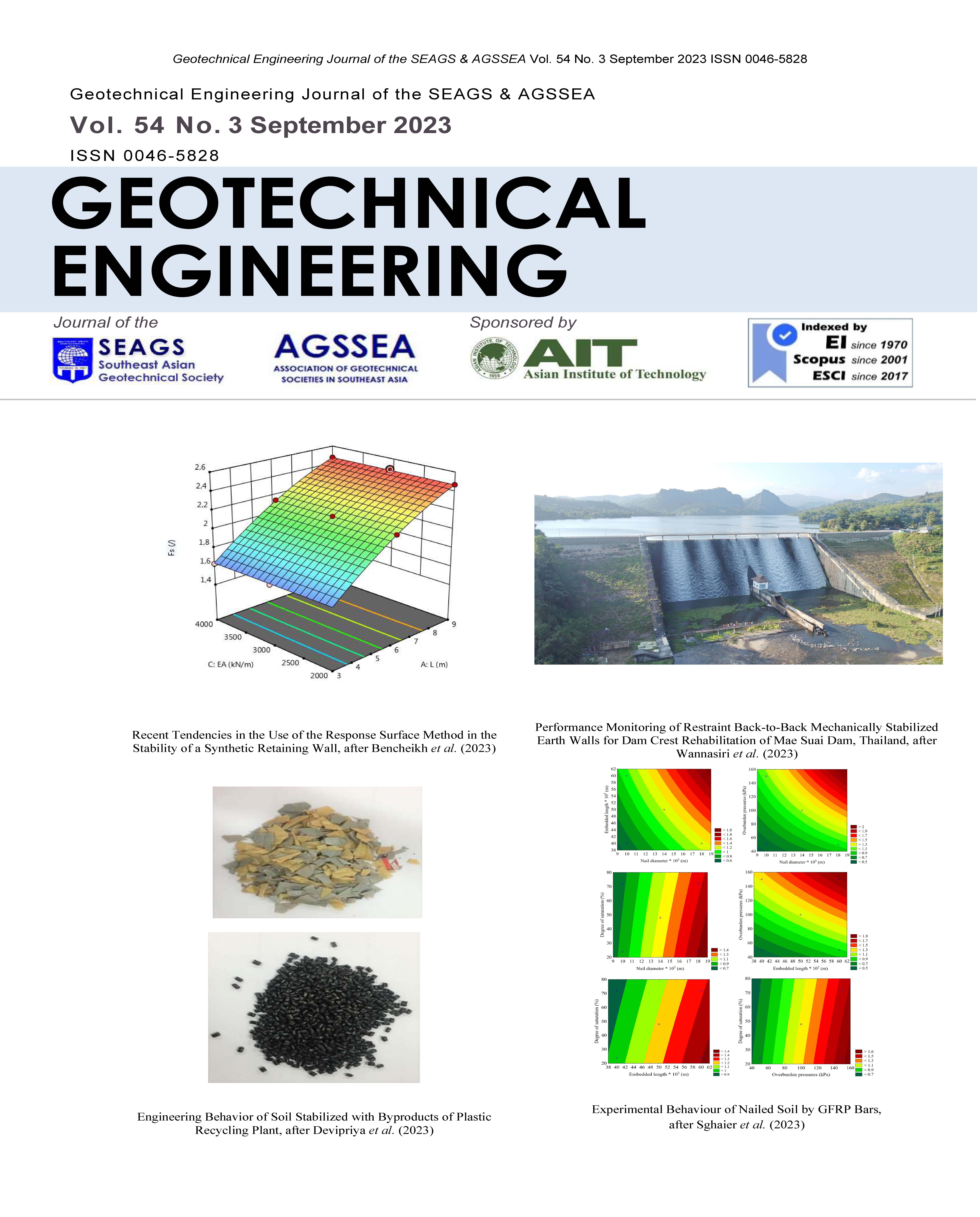Engineering behavior of soil stabilized with byproducts of plastic recycling plant
Main Article Content
Abstract
Reutilization of waste materials in constructional activities is always preferable due to the economical point of view and as an environmentally friendly approach. Hence the use of recycled plastics, which is always creating lots of environmental issues as an additive in soils during constructional activities is an economic alternative for many soil improvement techniques. In this study two form of by products produced during different stages of plastic recycling process is directly used as an additive for soil samples. The shear strength and compressibility characteristics of two different types of soil samples mixed with varying percentages of recycled products are evaluated. From the test results it was observed that the shear strength parameters of the sample were improved, and the compressibility parameters of the sample were reduced with addition of recycled plastic into the sample.
Article Details

This work is licensed under a Creative Commons Attribution-NonCommercial-NoDerivatives 4.0 International License.
Copyright © 2019 Association of Geotechnical Societies in Southeast Asia (AGSSEA) - Southeast Asian Geotechnical Society (SEAGS).
References
• Arulrajah, A., Yaghoubi, E., Wong, Y. C., & Horpibulsuk, S. (2017). Recycled plastic granules and demolition wastes as construction materials: Resilient moduli and strength characteristics. Construction and building materials, 147, 639-647.
• Babu, G. L., Chouksey, S., Anoosha, G., & Manjari, K. G. (2010, December). Strength and compressibility response of plastic waste mixed soil. Indian Geotechnical Conference-2010.
• Benson, C. H., & Khire, M. V. (1994). Reinforcing sand with strips of reclaimed high-density polyethylene. Journal of Geotechnical Engineering, 120(5), 838-855.
• Choudhary, A. K., Jha, J. N., & Gill, K. S. (2010). Utilization of plastic wastes for improving the sub-grades in flexible pavements. In Paving materials and pavement analysis (pp. 320-326).
• Chebet, F. C., & Kalumba, D. (2014). Laboratory Investigation on Re-Using Polyethylene (Plastic) Bag Waste Material for soil reinforcement in Geotechnical Engineering. Civil Engineering and Urban Planning, An International Journal (CiVEJ), 1(1), 67.
• Consoli, N. C., Montardo, J. P., Prietto, P. D. M., & Pasa, G. S. (2002). Engineering behavior of sand reinforced with plastic waste. Journal of Geotechnical and Geoenvironmental Engineering, 128(6), 462- 472.
• Dutta, R. K., & Venkatappa Rao, G. (2004). Engineering properties of sand reinforced with strips from waste plastic. In Proceedings of the international conference on geotechnical engineering, Sharjah, UAE (pp. 186-193).
• Laskar, A., & Pal, S. K. (2013). Effects of waste plastic fibers on compaction and consolidation behavior of reinforced soil. EJGE, 18, 1547-1558.
• Muntohar, A. S., Widianti, A., Hartono, E., & Diana, W. (2012). Engineering properties of silty soil stabilized with lime and rice husk ash and reinforced with waste plastic fiber. Journal of Materials in Civil Engineering, 25(9), 1260-1270
• Naeini, S. A., & Rahmani, H. (2016). Effect of Waste Bottle Chips on Strength Parameters of SiltySoil. MH, 43(21), 22.
• Ojuri, O. O., & Ozegbe, A. O. (2016). Improvement of the Geotechnical Properties of Sandy Soil Using Shredded Polyethylene Terephthalate (PET) Wastes. Geo-Chicago 2016 (pp. 52-60).
• Peddaiah, S., Burman, A., & Sreedeep, S. (2018). Experimental Study on Effect of Waste Plastic Bottle Strips in Soil Improvement. Geotechnical and Geological Engineering, 36(5), 2907-2920.
• Rawat, P., & Kumar, A. (2016). Study of CBR Behaviour of Soil Reinforced With HDPE Strips.Indian Geotechnical Conference -2016.
• Sivakumar Babu, G. L., & Raja Jaladurgam, M. E. (2014). Strength and deformation characteristics of fly ash mixed with randomly distributed plastic waste. Journal of Materials in Civil Engineering, 26(12), 04014093.
• Soltani-Jigheh, H. (2016). Compressibility and shearing behavior of clayey soil reinforced by plastic waste. International Journal of Civil Engineering, 14(7), 479-489.


